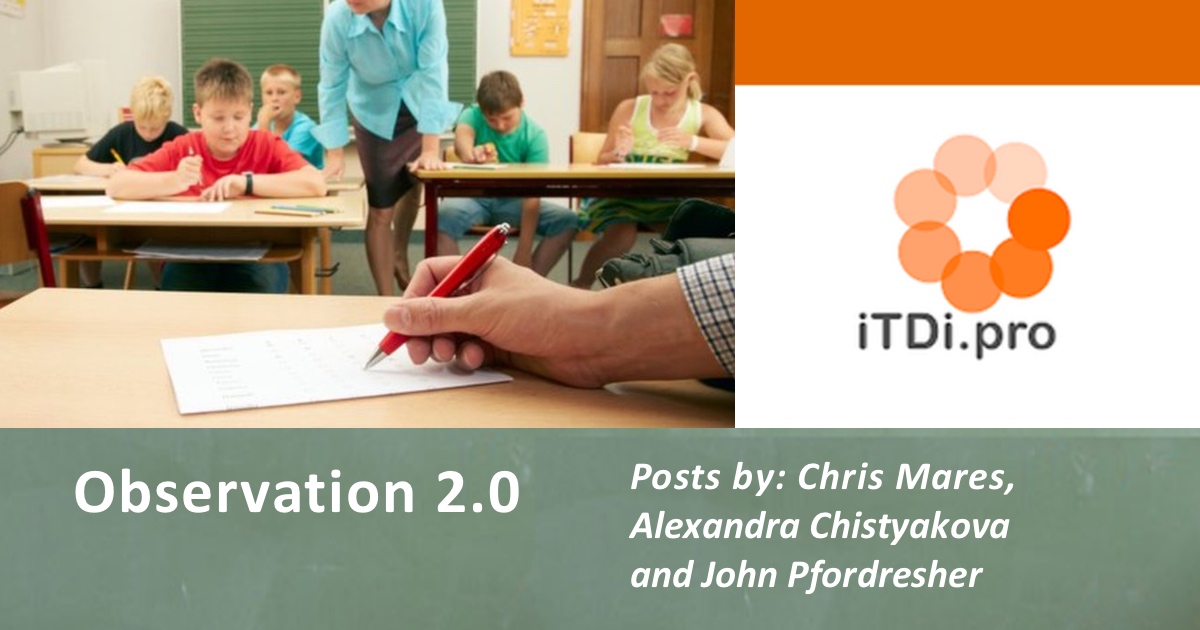
By John Pfordresher
Opening a classroom to observation can be unnerving. Anxiety, resentment, and frustration are all commonly linked to teachers’ thoughts and discussions of the subject. Adding to that toxic milieu, most teachers only know of observation through the stressful prism of what is probably more accurately described as a performance review. These come along infrequently and are typically specially prepared for, which greatly diminishes the beneficial effects that quality observation can provide.
This post will argue for an entirely different perspective with regards to observation. Observation, rather than being scheduled and anxiety-ridden, can and should be a daily task teachers perform for themselves; an activity that will greatly benefit one’s teaching practice, one’s understanding of self and one’s ability to adjust to the needs of learners. I will begin with a discussion of a few successful methods of collecting observation data, after which we’ll further investigate the process of self-observation and look at what can be done with the data that’s been collected.
Self-observation Data-gathering Activities
To start, I’d like to share and explain a few activities that have proved useful in collecting objective and actionable data from my classroom. At this point it would be prudent for me to underline the fact that there is no “correct way” or “best time” to do any of the following, because two main outcomes will result regardless of when, how, or why you choose an activity. Tangible observation data will be the concrete product, while meta-awareness, engendered through the act of self-observation itself, will be the abstract outcome.
Mental Snapshots: Take a mental snapshot of the classroom and record as many of the descriptive details as possible from that moment. I find this exercise useful for pulling my train of thought into the present moment. One of the most difficult aspects of self-observation is maintaining an unbiased perspective of what is happening in your own classroom. Snapshots require actively honing our observational skills. This simple action takes less than a minute, grounds perceptions in objective realities, and provides a detailed account of a moment of the class, providing me with ample discrete data points on which to evaluate and assess at a later point in time.
Hot Notes: Hot notes are notes taken in the heat of the action. Quickly jotting down a thought, student comment, reaction or feeling provides useful tidbits of data. This activity is useful for keeping track of the “blips” within a lesson. By blips, I mean the informative, unintended or unforeseen happenings and/or comments that occur between the numerous actors within a classroom that can easily get lost in the turmoil of the experience of the lesson as a whole. I have found that hot notes help reacquaint me with decision points I deal with when teaching. Further, they serve to reconnect me with whatever I was feeling or thinking in that moment.
Objective/Subjective: This activity serves a dual purpose. It is a conduit through which I collect lots of useful data, but it also acts as an explicit check on my self-observations. Objectivity is not easily acquired or retained. Due to this, I find the purposeful act of recording notes in columns explicitly labeled as objective and subjective gives me the mental practice necessary to keep my perceptions as objective as possible. Furthermore, I have found that subjectively observing my classroom provides data useful in highlighting any unseen prejudice or favoritism.
Feedback: Utilize both informal and formal student feedback. Feedback is critical to successful learning, for both a student and a teacher. Tune student feedback to include questions that will provide additional data for you to utilize in reflection. Students experience your teaching practice frequently and are well placed to provide useful insight via their observations of your teaching.
Point and Click: I take a lot of photos of my classroom. Typically, I record the notes I write on the blackboard, classroom set-up, as well as student-produced work. A lot of observable information can be gleaned from a photo. The first time I took a picture of my whiteboard and came back to look at it later I was horrified to see how disorganized it all looked. I began to self-observe my board work. Doing so has led to countless outcomes. By focusing on my board work, I have been forced to make lesson objectives and goals more explicit, which has led to more forethought with regards to possible learner hurdles and/or questions that might arise. This, in turn, has led to adjustments in my planned activity on the board. Additionally, photos can act as a sort of proof or counter-point to observations noted during a lesson.
ANYTHING really: These are only a few options that I have had success with. Anything one can do to increase and improve the quality of observation data will be beneficial to the self-observation process.
The Process of Self-Observation
The process of observation does not begin with collecting data from a classroom. Prior to beginning observation, it is critical to identify specific aspects of our teaching practice we aim to study. I usually choose one primary aspect for observation and one or two secondary foci for attention during the lesson.
What do we focus on? This question can be daunting, as there are so many moving parts of a classroom. The following is an extremely abbreviated list of a few areas of focus I consider prior to self-observation:
* Student-to-student interactions
* Student-to-teacher interactions
* Student reactions/responses to methods, activities, tasks, etc
* Student reactions/responses to teacher requests
* Teacher-talk
* Teacher positioning (where you are when you are doing what)
* Board work
* Giving directions/instructions
* Timing/time-management
* Lesson structure
* Feedback
* Décor/location alterations/changes
Having explicit, concrete ideas of what I will focus my observation on helps keep me on track when confronted with the melee that is a classroom. Staying focused in this way provides data that are more relevant and useful in evaluation. Unfocused observation tends to produce a deluge of uncorrelated data that will drown out worthwhile insights or trends.
Making Use of all that Data
I’ve got all sorts of data, now what?
This is perhaps the trickiest part of self-observation. When being observed by a supervisor or peer there is (usually) a pre- and post-lesson discussion. When doing it on your own, it is quite easy to finish class and drop the observation ball. By this, I mean the prep work and in-class observational work is all done, but the data ends up sitting on a desktop (real or virtual) unanalyzed.
Data is helpful, but without appropriate classification it can easily turn into a mountain of anxiety. Being a complex organism, every classroom and every day will present unique data points that do not lend themselves to a one-size-fits-all organizational structure. Determining your own best practices in data organization will take some time and effort. Indeed, most critical to successful management of your observation data is whichever method you choose makes sense to you and your context.
Beware of the Encroachment of Certainty
Self-observation is anathema to certainty. Readers may wonder at this statement. Isn’t self-observation supposed to bring our understanding out of opaqueness and into the light of clarity? Yes, and no. Self-observation provides those ‘ah-ha!’ moments, however complex systems (that classrooms are) are ever-changing organisms. The clarity of today reverts to opacity tomorrow. Self-observation disabuses us of holding onto a notion of certainty around our practice. It provides the necessary data to expand our pedagogical knowledge and our understanding of self. It delivers insight and offers the navigational clues as to a positive course for future action. However, it also constantly calls our assumptions into question. It is one of the most important tools I have in my teaching toolbox, and I hope (if it isn’t already) that it will become a useful tool in yours as well.


